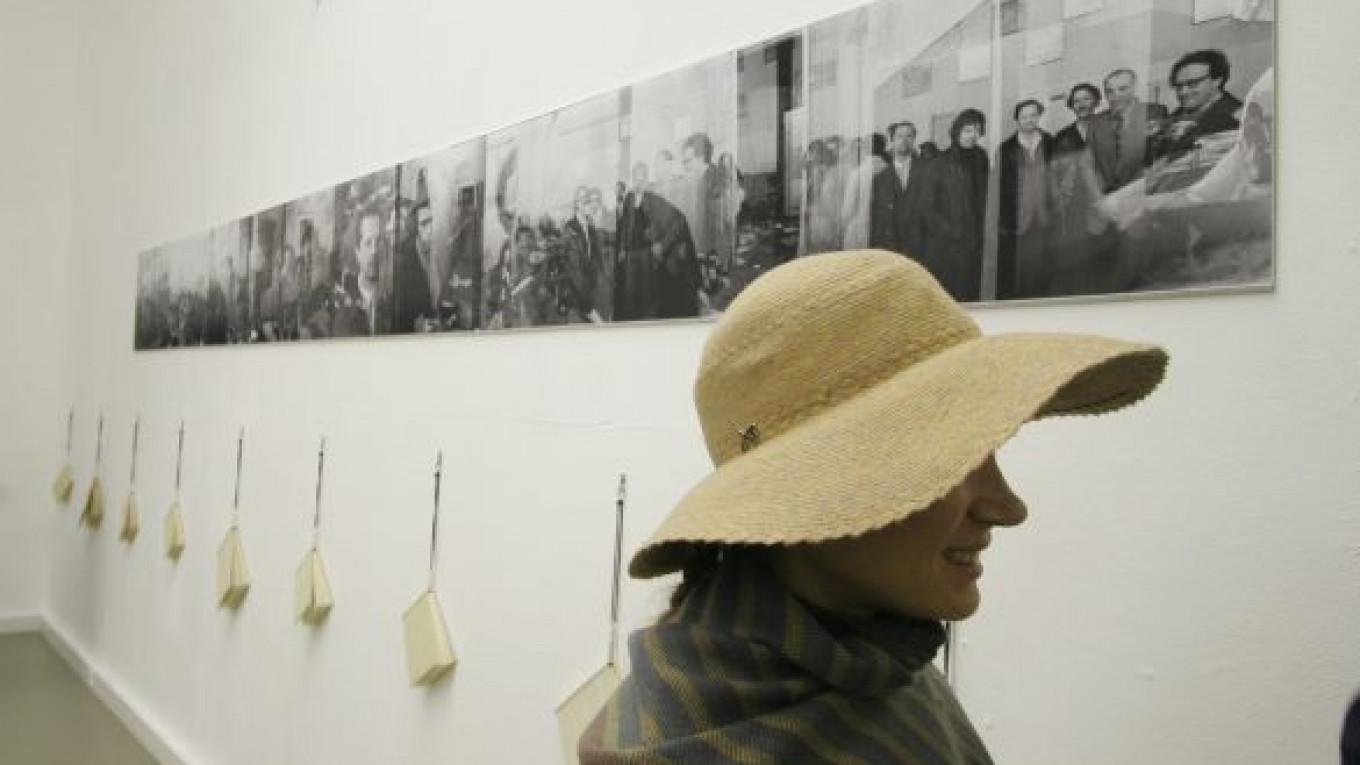In an installation at the XL Gallery, Moscow conceptual artist Igor Makarevich returns to an intimate memory from his past — saying goodbye to his friends Konstantin and Tatiana Erastov and their seven children as they emigrated to the West in 1979. In the ’60s and ’70s, the Erastovs’ apartment served as a vibrant meeting place for Moscow’s dwindling community of Soviet intelligentsia. The exhibit mixes panoramic photographs of their departure with handmade albums of family photos, fragments of scribbled-on wallpaper from the apartment, and Makarevich’s reconstruction of other wallpaper drawings.
The double-exposed panoramic photographs at the heart of the exhibition were an unintentional creation. Makarevich initially used the film to photograph the Erastovs biding farewell to friends who had gathered to wish them off at Sheremetyevo Airport. After the family disappeared beyond the boarding gate, Makarevich returned to the apartment one last time to photograph its remnants: piles of shoes, empty bottles, and the children’s farewell messages on the wall. Distraught, Makarevich accidentally filmed the apartment pictures on top of those he had taken at the airport.
Makarevich only realized his mistake while developing the film. “I was in horror because everything was ruined,” he said. However, he quickly realized that he had achieved a “fantastic superimposition,” in which the Erastovs’ final goodbye is suffused with ghostly images of the life they left behind. “I couldn’t have done it better consciously,” Makarevich said. In comparison, the shots he took correctly — included in the photo albums hanging beneath the panoramas — are “surprisingly weaker.”
In addition to these parting shots, the photo albums are filled with the Erastovs’ family photos of quiet moments at the dacha and at home. They also contain Makarevich’s photos of the Moscow evenings when both permanent friends and a rotating cast of artists, academics and writers gathered at the family’s apartment, eating, drinking, playing music, reading poetry and arguing passionately late into the night.
The albums hang from old dry cleaner tags, numbered to identify their owner, which Makarevich kept from the Soviet era. He said they serve as “a kind of official number that depersonalizes the individual,” a haunting reminder of the “captivity” that the Erastovs and their circle sought to escape.
Konstantin and Tatiana Erastov, like many of their friends, were Jews by birth who adopted Christianity as an alternative to Communism. After graduating from university in the late ’50s, the Erastovs moved to the countryside with their children and several friends, embarking on a mission to teach and work alongside peasants in the Christian tradition of Leo Tolstoy. But after a year or so of village life, they became discouraged and returned to Moscow.
Grigory Natapov, who was Konstantin Erastov’s best friend and appears in many of the exhibit’s photos, said Konstantin’s involvement in Soviet underground circles had first begun in 1955, when the friends became acquainted with a group of intellectuals who had recently returned from the gulag. In the mid-’50s, the Khrushchev thaw was beginning to offer greater possibilities for individuals to question official dictates. People gathered in places as big as Pushkin Square or as small as a kitchen table to exchange literature and ideas.
Upon returning to Moscow at the dawn of the ’60s, the Erastovs purchased an apartment in the center of the city, on Bolshoi Gnezdnikovsky Pereulok, and entered the Thaw in its full bloom. “The house was open around the clock, the doors never closed, and anyone who wanted to came,” Natapov said.
Around the kitchen table, writers, artists, and political activists played the guitar, dissected early 20th-century Russian writers, shared copies of new samizdat works, and wrote letters to protest human rights abuses. Makarevich remembers the theme uniting these evenings as “the idealization of the West.”
It seemed to us that all the terrible parts of human nature were developed here, and if you moved abroad, everything would be OK,” he said.
While in some ways the Erastovs’ apartment was a haven, it could also be a place of danger. As crackdowns on dissidents rose throughout the ’70s, stretches of tranquility were punctured by fear. In 1973, Viktor Krasin and Pyotr Yakir, frequent visitors at the Erastovs’ who had founded a group to support human rights in the Soviet Union, were sentenced to three years of confinement and three years of exile for “anti-Soviet agitation.”
Ksenia Atarova, another member of the Erastovs’ circle, said reactions to such crackdowns “varied from person to person.” On one hand, Natapov, who was taken in for several days of police questioning in connection with distributing samizdat, said he “never experienced any fear.” On the other, Atarova’s husband, who had clear memories of the Stalinist repressions of the ’30s, constantly worried for their safety.
In 1979, the Erastov family attained visas to and fled their besieged Moscow community for Orthodox monasteries in the West. Tatiana and the daughters went to Chile, then France; some later moved to Australia. One child, Alyosha, rejected Christianity and emigrated instead to a community of Orthodox Jews in Israel (in Makarevich’s photographs from the airport, Alyosha appears with recently self-cut payot, Orthodox Jewish side curls). None of the family has ever returned to Russia.
In 1989, as the Soviet Union was falling apart and travel abroad became easier, Makarevich had the opportunity to meet with Tatiana and her daughters in Paris. Seeing his friends for the first time in 10 years, Makarevich said they seemed discouraged by the unexpected difficulties of their new lives. “The idealization of the West is one thing … but to live concretely in certain conditions is another,” he said.
Today, Makarevich’s own feelings toward the system he and his friends once railed against are also bittersweet. “We didn’t understand that the emptiness which surrounded us in Soviet times was a very important means of nourishment for our art,” he said. “We knew how to struggle against [Soviet authority], how to deceive them. We possessed the skills for this.
“But evading the powerful, commercial world that replaced it? That’s much more difficult.”
“The Erastovs’ House” is on till Nov. 28 at the XL Gallery, 4th Syromyatnichesky Pereulok, Bldg. 6. Metro Chkalovskaya, Kurskaya. 1 to 8 p.m., closed Monday. Tel. 775-8373, http://xlgallery.artinfo.ru.
A Message from The Moscow Times:
Dear readers,
We are facing unprecedented challenges. Russia's Prosecutor General's Office has designated The Moscow Times as an "undesirable" organization, criminalizing our work and putting our staff at risk of prosecution. This follows our earlier unjust labeling as a "foreign agent."
These actions are direct attempts to silence independent journalism in Russia. The authorities claim our work "discredits the decisions of the Russian leadership." We see things differently: we strive to provide accurate, unbiased reporting on Russia.
We, the journalists of The Moscow Times, refuse to be silenced. But to continue our work, we need your help.
Your support, no matter how small, makes a world of difference. If you can, please support us monthly starting from just $2. It's quick to set up, and every contribution makes a significant impact.
By supporting The Moscow Times, you're defending open, independent journalism in the face of repression. Thank you for standing with us.
Remind me later.






